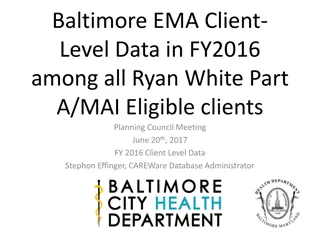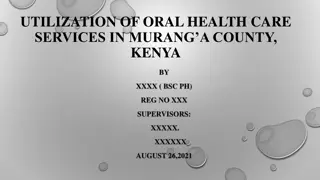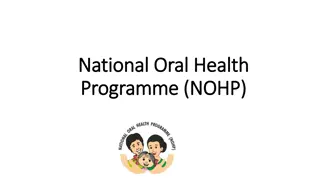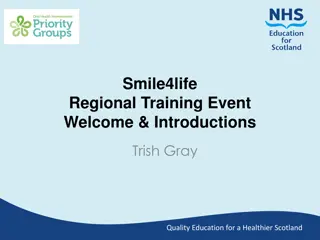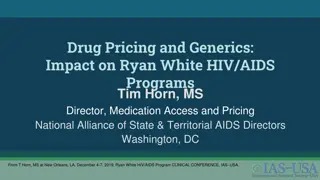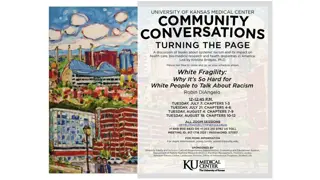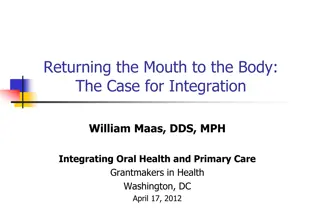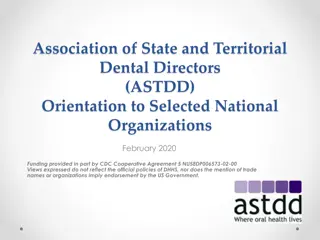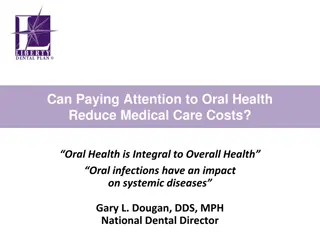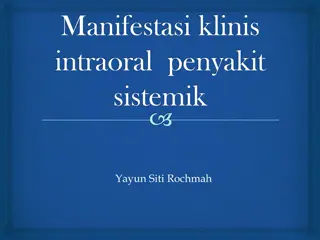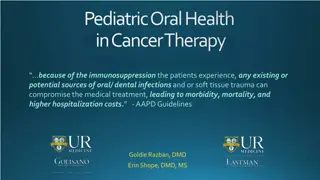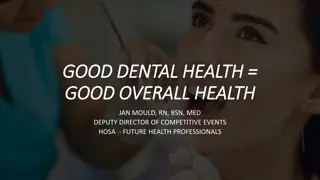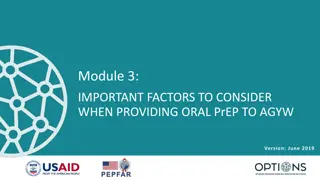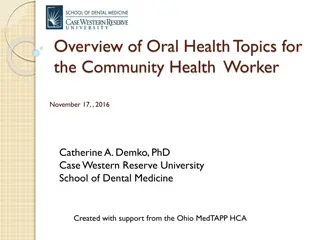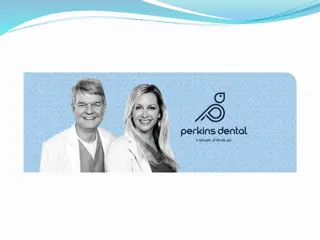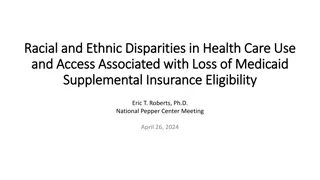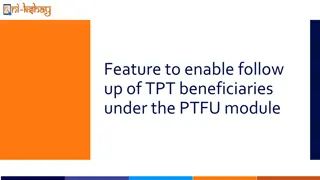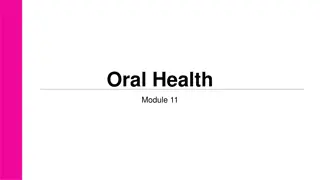Evaluation of Oral Health Services Utilization Among Ryan White Part-A Beneficiaries
Gurpreet Kaur, DDS, MPH, and the Greater Baltimore HIV Health Services Planning Council conducted a 2019 capstone project to assess low utilization of oral health services by Ryan White Part-A program beneficiaries. Consequences of poor dental health, impact of HIV on oral health, data collection methods, sample size, outcome variables, and demographic characteristics of the beneficiary population were analyzed.
Download Presentation

Please find below an Image/Link to download the presentation.
The content on the website is provided AS IS for your information and personal use only. It may not be sold, licensed, or shared on other websites without obtaining consent from the author. Download presentation by click this link. If you encounter any issues during the download, it is possible that the publisher has removed the file from their server.
E N D
Presentation Transcript
TO EVALUATE THE LOW UTILIZATION OF ORAL HEALTH SERVICES BY BENEFICIARIES OF RYAN WHITE PART-A PROGRAM 2019 Capstone Project, Gurpreet Kaur, DDS MPH Epidemioloy University of Maryland Greater Baltimore HIV Heath Services Planning Council Patrick Chaulk, MD, MPH
Consequences of poor dental health Gum disease Tooth decay Tooth erosion Mouth sores Tooth sensitivity, aches and emergencies Oral cancer Cosmetic needs Bad breath Negative impact on healthy diet
Consequences of HIV and oral health Increased susceptibility to dental infections Mouth: first body part to be affected by HIV infection People with HIV may experience: Dry mouth Thrush/Candidiasis Oral hairy leukoplakia Red band gingivitis Kaposi s sarcoma HSV-1 infections Mouth ulcers (Pakfetrat et. al., 2015)
Data collection CAREWare, 2017 data Nature of data collected Administrative Clinical Support service data Tabular reports completed annually by Ryan White grantees and their subcontractors
Sample size Sample size: Sample Size= 12,452 Total= 12,462 Duplicates= 10 Inclusion criteria: patients receiving medical, non-medical or support services under Ryan White Part-A program
Outcome variable Oral health care services utilization Did not have an oral health visit Had an oral health visit
Age AGE (in years) 02-24 13-24 25-45 46-65 >65 N (%) 31 (0.25) 471 (3.78) 4193 (33.67) 6886 (55.30) 871 (7.00)
Gender GENDER Male Female Transgender Unknown N (%) 7693(61.78) 4562 (36.63) 154 (1.24) 43 (0.35)
Race & Ethnicity RACE & ETHNICITY White African-American Hispanic Other Not Specified N (%) 1739 (13.96) 9605 (77.14) 401 (3.22) 466 (3.74) 241 (1.94)
Insurance Status Medicaid Medicare Private Other Unknown No Insurance 5123 (41.14) 2501 (20.08) 2490 (20.00) 170 (1.37) 1310 (10.52) 858 (6.89)
Income Status INCOME $0 - $20,000 $21,000 - $40,000 $41,000 - $60,000 >= $61,000 Missing Value N (%) 8879 (71.87) 1250 (10.12) 498 (4.03) 1727 (13.98) 98 (0.007)
Oral health visits ORAL HEALTH VISITS N (%) Did not have a visit 10332 (82.97) Had a visit 2120 (17.03)
Population Characteristics Based on Access to Oral Health Visits STUDY VARIABLES TOTAL N=12452 DID NOT HAVE ORAL HEALTH VISIT N=10332 HAD ORAL HEALTH VISIT N=2120 P-VALUE Age (in years) 02-12 13-24 25-45 46-65 >65 <0.0001 31 (0.25) 471 (3.78) 4193 (33.67) 6886 (55.30) 871 (6.99) 30 (96.77) 449 (95.33) 3633 (86.64) 5514 (80.08) 706 (81.06) 1 (3.23) 22 (4.67) 560 (13.36) 1372 (19.92) 165 (18.94) Race & Ethnicity White African-American Hispanic Not Specified Other 0.0085 1739 (13.97) 9605 (77.14) 401 (3.22) 241 (1.94) 466 (3.74) 1464 (84.19) 7965 (82.93) 334 (83.29) 180 (74.69) 389 (83.48) 275 (15.81) 1640 (17.07) 67 (16.71) 61 (25.31) 77 (16.52) Gender Female Male Transgender Unknown 0.0453 4572 (36.64) 7693 (61.78) 154 (1.24) 43 (0.35) 3788 (83.03) 6366 (82.75) 140 (90.91) 38 (88.37) 774 (16.97) 1327 (17.25) 14 (9.09) 5 (11.63)
Population Characteristics Based on Access to Oral Health Visits STUDY VARIABLES TOTAL N=12452 DID NOT HAVE ORAL HEALTH VISIT N=10332 HAD ORAL HEALTH VISIT N=2120 P-VALUE Insurance Medicaid Medicare Private Other Unknown No Insurance <0.0001 5123 (41.14) 2501 (20.09) 2490 (20.00) 170 (1.37) 1310 (10.52) 858 (6.89) 4262 (83.19) 1947 (77.85) 2147 (86.22) 152 (89.41) 1261 (96.26) 563 (65.62) 861 (16.81) 554 (22.15) 343 (13.78) 18 (10.59) 49 (3.74) 295 (34.38) Housing Stable Unstable Unknown 0.0011 9009 (73.35) 704 (5.65) 2739 (22.00) 7504 (72.63) 608 (86.36) 2220 (81.05) 1505 (16.71) 96 (13.64) 519 (18.95) Income $0.00-$20,000 $21,000-$40,000 $41,000-$60,000 >=$61,000 <0.0001 8879 (71.87) 1250 (10.12) 498 (4.03) 1727 (13.98) 7490 (84.36) 1068 (85.44) 400 (80.32) 1292 (74.81) 1389 (15.64) 182 (14.56) 98 (19.68) 435 (25.19)
Findings Oral health utilization is low Barriers: Income Insurance Viral loads Not retained in care Protective factors Age Public insurance: Medicaid, Medicare, Ryan White
Next Steps Utilization is low, but why? Is there a provider capacity issue? MSA versus jurisdictions Best practices local and national Focus group and key informant interviews and/or surveys Clients Providers Develop effective education campaign: clients and providers Identify potential partners: State pilot program for dual eligibles University of Maryland Dental School Maryland Dental Association


